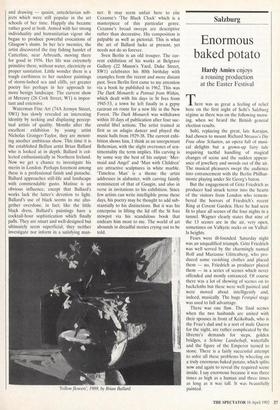Exhibitions
Joan Eardley (Mercury Gallery, till 9 May) Brian Ballard (Waterman Fine Art, till 30 April) Sven Berlin (Belgrave Gallery, till 23 April)
Armed for warfare
Giles Auty
Joan Eardley, who is recognised today as a leading woman artist of her generation would not have had her considerable tal- ents qualified by gender at the time of her early death in 1963. To the best of my rec- ollection, the expression 'woman artist' emerged in Britain some 12-15 years later; prior to that we were all simply artists, good or bad. Certainly my own first encounter with gender warfare in the arts came as recently as 15 years ago via an attractive young American woman. She had suggested lunch at a smart restaurant to discuss a book I had recently written. Since the so-called discussion consisted entirely of her pointing out examples of supposed sexism in my text, the lunch proved less agreeable than I had envisaged. Indeed, if I had known the likely nature of the experi- ence in advance I would have limited my invitation to her to just a beer and a ploughperson's.
Although Joan Eardley is thought of by many as a Scottish artist, she spent the first 18 years of her life in the South of Eng- land. Her early studies were conducted at Blackheath and Goldsmith's Schools of Art long before the latter devoted itself to encouraging its pupils to display dead fiSh or other taxing exercises. It was at Glasgow that Eardley pursued her study of painting and drawing — quaint, antedeluvian sub- jects which were still popular in the art schools of her time. Happily she became rather good at both. Armed with her strong individuality and humanitarian vigour she began to produce powerful evocations of Glasgow's slums. In her late twenties, the artist discovered the tiny fishing hamlet of Catterline, near Arbroath, moving there for good in 1956. Her life was extremely primitive there, without water, electricity or proper sanitation. Little wonder there is a tough earthiness to her outdoor paintings of storm-lashed sea and cliffs, yet greater poetry lies perhaps in her approach to more benign landscape. The current show at Mercury (26 Cork Street, W1) is impor- tant and extensive.
Waterman Fine Art (74A Jermyn Street, SW1) has slowly revealed an interesting identity by seeking and displaying percep- tual artists of quality. Months after the excellent exhibition by young artist Nicholas Granger-Taylor, they are mount- ing another ambitious show. This time it is the established Belfast artist Brian Ballard who is looked at in depth. Ballard is col- lected enthusiastically in Northern Ireland. Now we get a chance to investigate his merits in London. Perhaps foremost among these is a professional finish and panache. Ballard approaches still-life and landscape with commendable gusto. Matisse is an obvious influence, except that Ballard's works lack the latter's devotion to light. Ballard's use of black seems to me alto- gether overdone, in fact; like the little black dress, Ballard's paintings have a cocktail-hour sophistication which finally palls. They are smart and well-designed but ultimately seem superficial; they neither investigate nor inform in a satisfying man- ner. It may seem unfair here to cite Cezanne's 'The Black Clock' which is a masterpiece of this particular genre. Cezanne's broad sweeps are descriptive rather than decorative. His composition is palpable as well as pictorial. This is what the art of Ballard lacks at present, yet needs not do so forever.
Sven Berlin is an old trouper. The cur- rent exhibition of his works at Belgrave Gallery (22 Mason's Yard, Duke Street, SW1) celebrates his 80th birthday with examples from the recent and more distant past. Sven Berlin first came to my attention via a book he published in 1962. This was The Dark Monarch: a Portrait from Within, which dealt with his days in St Ives from 1945-53, a town he left finally in a gypsy caravan en route for a new life in the New Forest. The Dark Monarch was withdrawn within 10 days of publication after four suc- cessful libel actions. The artist trained at first as an adagio dancer and played the music halls from 1929-38. The current exhi- bition shows him, I think as an unrepentant Bohemian, with the slight overtones of sen- timentality the term implies. His carving is by some way the best of his output: 'Mer- maid and Angel' and 'Man with Children' are attractive sculptures in white marble. `Timeless Man' is a theme the artist addresses in alabaster, with carving faintly reminiscent of that of Gaugin, and also in verse in invitations to his exhibition. Since few artists can write intelligible prose these days, his poetry may be thought to add sub- stantially to his distinctions. But it was his enterprise in lifting the lid off the St Ives stewpot via his scandalous book that endears him most to me. The world of art abounds in dreadful stories crying out to be told.
`Yellow flowers, 1989, by Brian Ballard



















































 Previous page
Previous page